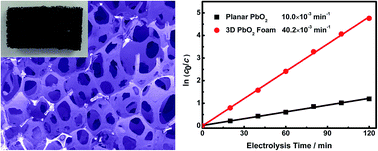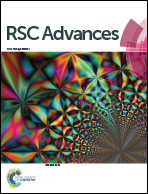Novel three-dimensional macroporous PbO2 foam electrode for efficient electrocatalytic decolorization of dyes†
Abstract
Electrode construction is a key factor for the efficient electrocatalytic degradation of organic contaminants. However, it is still a challenge to construct an electrode architecture with a large diffusion coefficient and high efficiency. Here, we used a facile method to successfully fabricate a three-dimensional macroporous foam architecture of a PbO2 electrode that possesses the same framework as low-cost macroporous sponges found in kitchens. This 3D architecture is monolithic and possesses continuous macroporous throughout with high interconnection. Compared with the traditional planar PbO2 electrode, the 3D macroporous PbO2 foam has significantly lowered electrochemical impedance (29.2 versus 410 ohm), and greater diffusion coefficient (41.8 × 10−6 versus 2.29 × 10−6 cm2 s−1). Moreover, the electrocatalytic dye decolorization experiments show that the 3D macroporous PbO2 foam possesses a much larger first-order kinetics constant (40.2 × 10−3 versus 10.0 × 10−3 min−1 for highly concentrated orange II). Higher specific surface area, significantly enhanced mass transport, and excellent electrocatalytic activity of the as-fabricated PbO2 foam can make it a promising electrocatalytic electrode for wastewater treatment.


 Please wait while we load your content...
Please wait while we load your content...